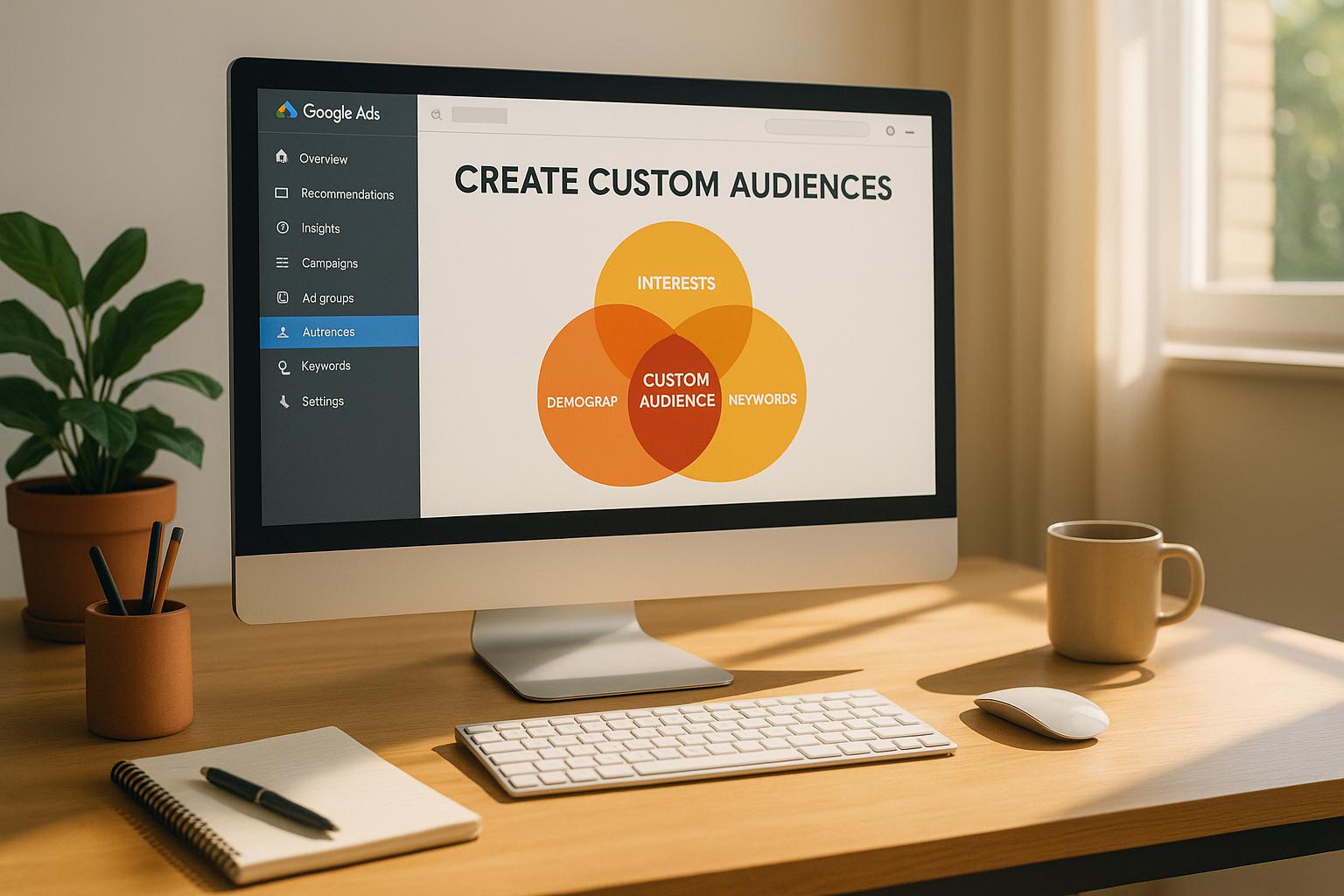Want to improve your PPC campaigns? Start with the right attribution tool. Attribution modeling helps track how each customer interaction contributes to conversions, ensuring smarter budget allocation and better campaign performance. Here are five tools that stand out for their ability to support custom attribution models:
- Google Analytics 4 (GA4): Ideal for beginners, it offers free data-driven attribution and integrates seamlessly with Google Ads.
- Adobe Analytics: Best for enterprises, it supports advanced, rule-based models with deep integration into Adobe's ecosystem.
- Segment (by Twilio): Centralizes data across 450+ tools, making it a strong choice for businesses needing unified insights.
- LeadsRx: Designed for real-time, multi-touch attribution with integrations for e-commerce and CRM platforms.
- HockeyStack: Tailored for B2B marketers, it provides detailed insights into touchpoints and integrates with popular CRMs.
Quick Comparison
| Tool | Attribution Models | Integrations | Pricing | Best For | Business Size |
|---|---|---|---|---|---|
| Google Analytics 4 | Multi-touch, data-driven | Google Ads, BigQuery | Free or $50k+ | Beginners, SMBs | Small to Medium |
| Adobe Analytics | Advanced, rule-based | Adobe Experience Cloud, Salesforce | Custom Pricing | Enterprises with complex needs | Enterprise |
| Segment (by Twilio) | Custom, unified data | 450+ tools, incl. Shopify, HubSpot | Contact for details | Centralized data collection | Medium to Large |
| LeadsRx | Multi-touch, real-time | Shopify, Salesforce, HubSpot | Contact for details | Accurate campaign tracking | Enterprise |
| HockeyStack | Flexible, B2B-focused | Salesforce, HubSpot, Google Ads | $2,200+/month | B2B attribution | Medium to Enterprise |
The right choice depends on your goals, data complexity, and budget. Whether you're a small business or an enterprise, these tools can help you refine your PPC strategies and drive better results.
Decoding attribution with Google Analytics | PPC Town Hall 34
1. Google Analytics 4 (GA4)
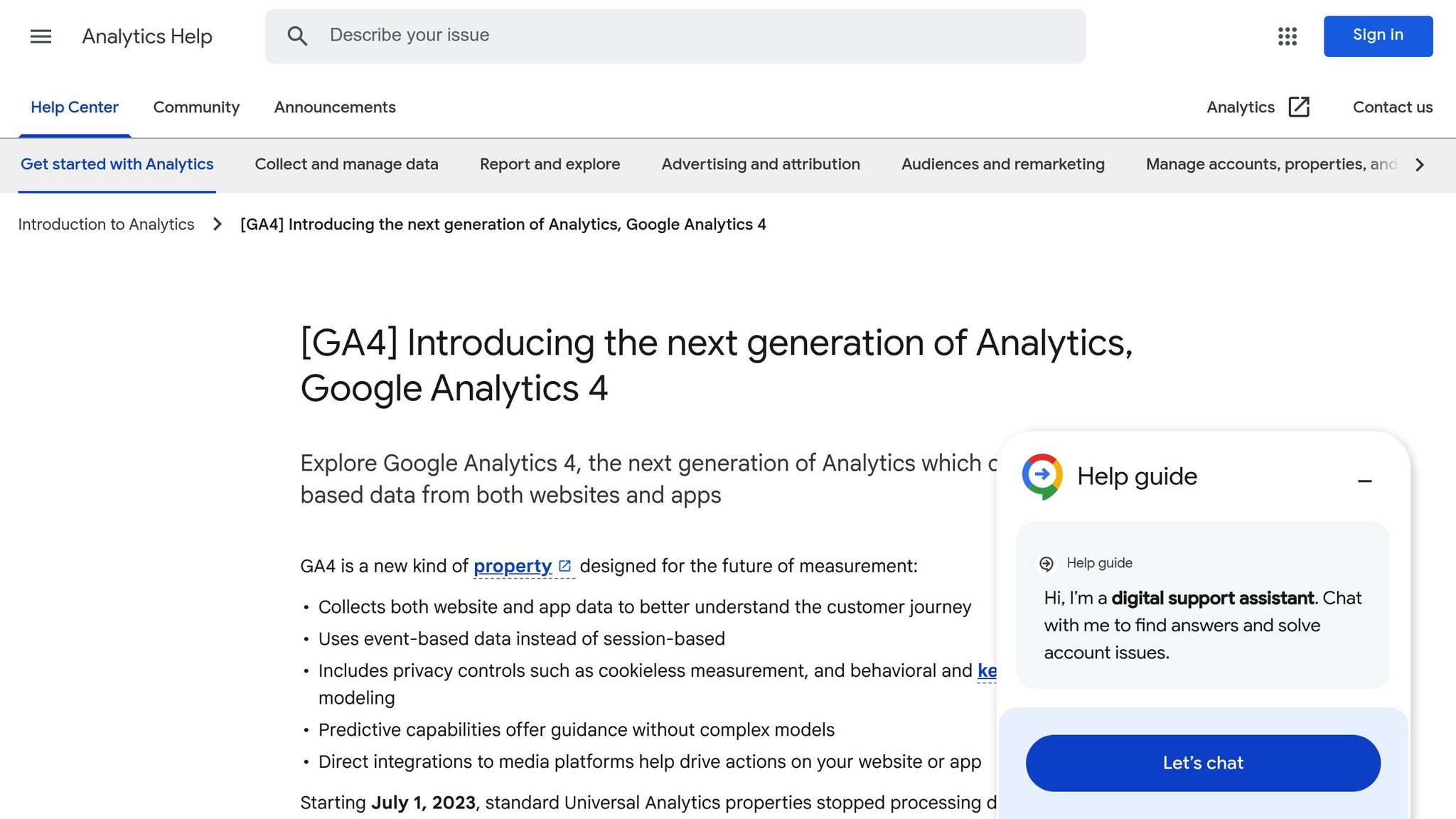
Google Analytics 4 (GA4) offers businesses a straightforward way to dive into advanced attribution modeling. As Google's latest analytics platform, it steps beyond the limitations of Universal Analytics by introducing a machine learning–powered Data-Driven Attribution (DDA) model. This model assigns conversion credit based on actual contributions, analyzing both converting and non-converting customer paths to provide a more accurate picture of performance.
GA4 gives users control over attribution settings, allowing them to assign credit to ads, clicks, and marketing channels. It also provides customizable event lookback windows, with default settings of 30 days for acquisition, 90 days for other events, and 3 days for engaged views. Experts suggest adjusting these windows to 7 days for acquisition and 30 days for other events to improve accuracy.
Integration Capabilities with Data Sources and Marketing Tools
GA4 seamlessly integrates with Google Ads, enabling smooth data sharing and a clearer view of the customer journey. It also connects with other tools in Google’s ecosystem, such as Search Ads 360, Display & Video 360, Google Cloud, and Google Search Console, consolidating marketing performance data for better insights. Cross-channel reporting helps marketers identify which combinations of channels deliver the best results, allowing for smarter budget allocation. For example, McDonald's Hong Kong boosted in-app orders by 550% by leveraging these features.
"Google Analytics allows us to look at our data across platforms - web and app - to understand the full journey of our users. We've been able to cut our reporting time by 50%." - Sara Swaney, Director of Advancement, 412 Food Rescue.
GA4 also offers a free integration with BigQuery, enabling businesses to export raw data for deeper analysis. Advanced users can use this feature to create custom attribution models with SQL and Python, bridging the gap between analytics and data science teams.
Pricing and Cost Structure
GA4 provides a free version that includes DDA, cross-platform tracking, and essential integrations. For enterprises needing more robust features, Google Analytics 360 starts at $150,000 per year, with entry-level pricing at $50,000 annually for up to 25 million monthly events. While the cost of BigQuery integration depends on data volume and query frequency, the connection itself is free. Most businesses find these expenses reasonable when weighed against the insights they gain.
Scalability and Suitability for Different Business Sizes
GA4 is built to grow with businesses, making it a fit for everything from small startups to large enterprises. Small businesses can take advantage of the free version's feature set, while medium-sized companies can use BigQuery integration for more advanced analytics. For large enterprises, Analytics 360 offers enhanced processing power and additional attribution tools. In one case study, a retail brand saw a 20% increase in conversion rates after utilizing GA4’s cross-platform features, demonstrating its effectiveness across various business scenarios.
2. Adobe Analytics
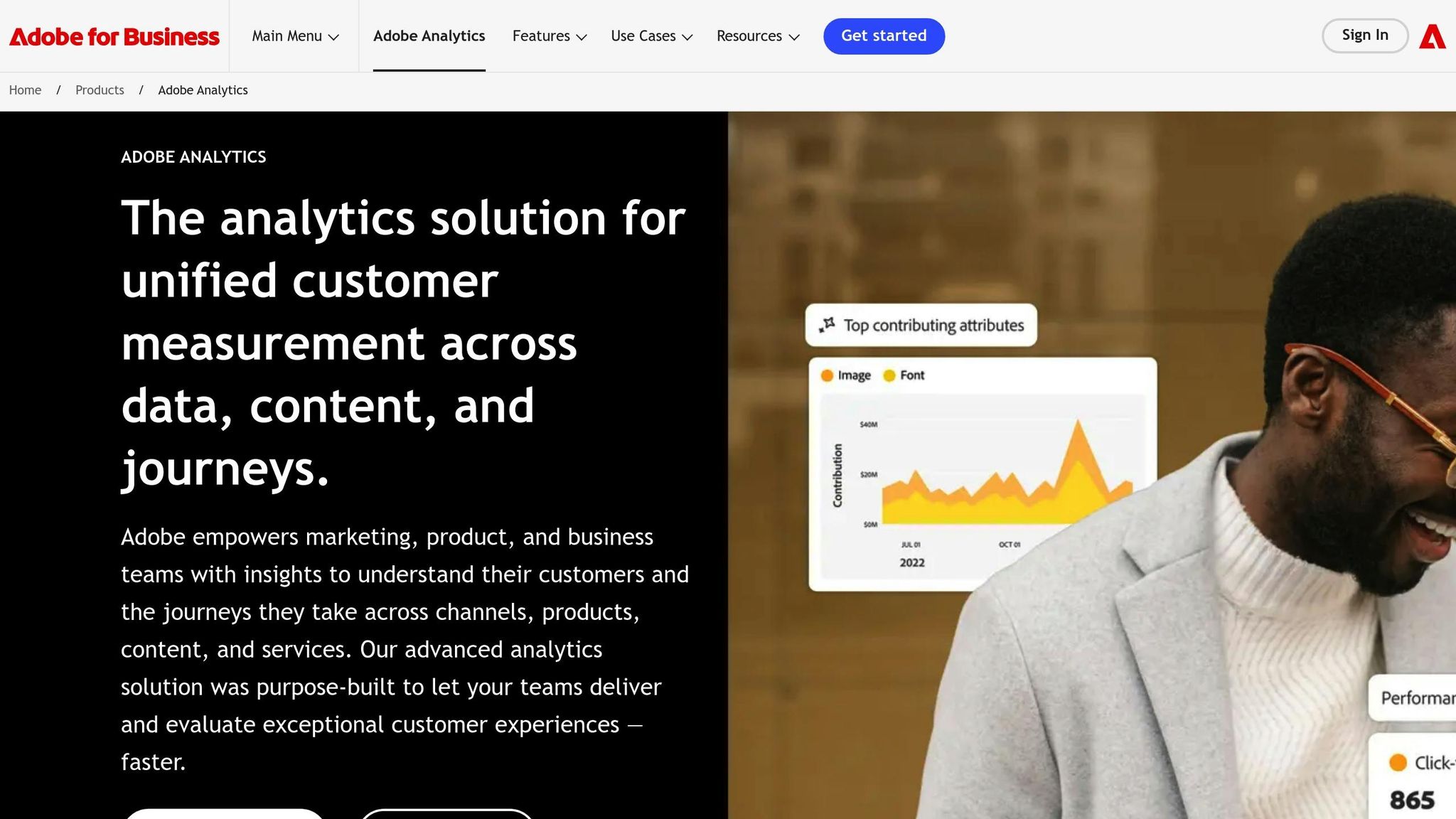
Adobe Analytics takes attribution modeling to the next level, offering advanced customization options designed for complex marketing setups. As an enterprise-level platform, it provides tools that allow businesses to tailor their attribution models to align with unique marketing strategies and customer behaviors.
Support for Custom Attribution Models
Adobe Analytics supports nine different attribution models, including Last Touch, First Touch, Linear, Time Decay, U-Shaped, J-Curve, Inverse J, Custom, and Algorithmic options. What sets it apart is its ability to create custom, rule-based models that assign specific weights to marketing channels based on their role in driving conversions. Using the platform’s rules editor, marketers can refine channel definitions and set conditions using query parameters, referrer domains, or custom scripts.
For instance, businesses can define conversion events, select a base model, and tweak credit allocation to align with their goals. This flexibility allows for both uniform and variable credit distribution, letting users focus on the marketing channels that deliver the most impact. Take an e-commerce company running campaigns across paid search and email marketing: while a Last Touch model might give all the credit to paid search, a Linear model would distribute credit evenly between both channels.
Integration Capabilities with Data Sources and Marketing Tools
Adobe Analytics offers over 200 integrations that help businesses maximize their investment in the Adobe Experience Cloud. It connects seamlessly with third-party tools via pre-built APIs, a drag-and-drop interface, and direct cloud connectors. Its deep integration with Adobe Experience Cloud enhances customer experiences and optimizes campaigns across multiple channels.
In one example, EY account teams using Adobe’s Customer Journey Analytics gained a comprehensive view of client interactions. This helped them identify decision-makers and areas of interest without needing extensive analyst support, enabling more meaningful client conversations. According to a Forrester Consulting study, businesses leveraging Adobe Experience Cloud, including Adobe Analytics, saw an ROI exceeding 330%. Additionally, the platform’s API offers developers tools for extensive customization and automation. These capabilities make Adobe Analytics a strong companion to other analytics tools, particularly for organizations seeking a holistic attribution strategy.
Pricing and Cost Structure
Adobe Analytics uses a custom pricing model based on the volume of data and specific business needs. Costs scale depending on the complexity of data processing and organizational requirements. For companies already using Adobe Experience Cloud products, the investment in Adobe Analytics often aligns well with their overall goals, making it a sound choice for those embedded in the Adobe ecosystem.
Scalability and Suitability for Different Business Sizes
Designed to handle large data volumes, Adobe Analytics is built for enterprise-level businesses. Its robust infrastructure ensures consistent performance even as data demands grow. The platform scales effectively, serving both growing startups and large enterprises with complex data needs. However, it’s particularly well-suited for organizations already using Adobe’s suite of tools.
That said, its advanced features often require skilled personnel to unlock its full potential. While Google Analytics remains the go-to for 77% of content marketers, only 39% use Adobe Analytics, reflecting its specialized focus on enterprise users. For businesses with intricate, multi-channel marketing strategies, Adobe Analytics provides the tools to track and analyze user interactions across a wide range of digital touchpoints.
3. Segment (by Twilio)
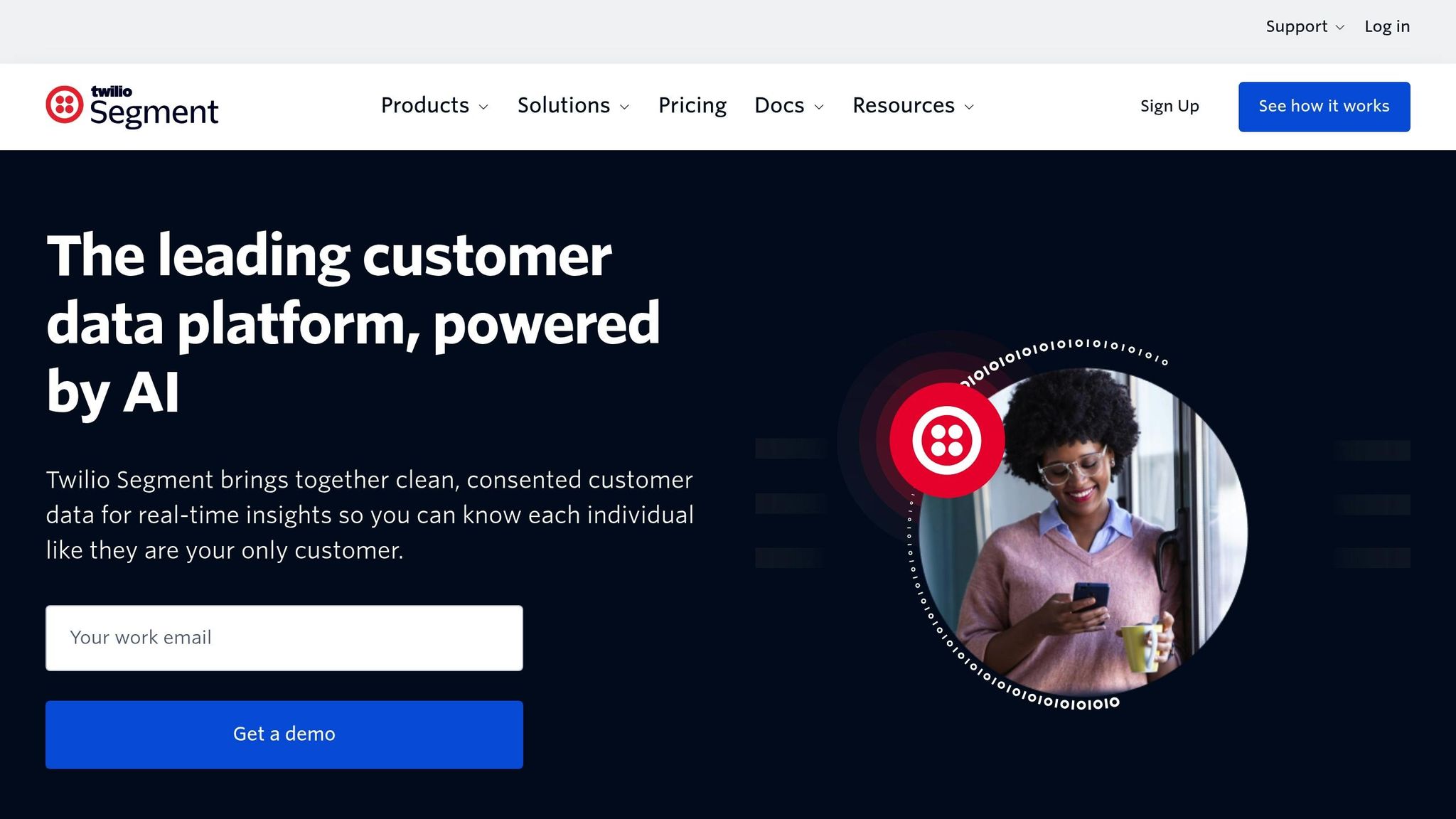
Segment by Twilio simplifies custom attribution modeling by pulling together data from various touchpoints to create unified, actionable insights. It doesn’t just track customer journeys - it also powers attribution insights across other tools, making it a key player in data-driven marketing.
Integration Capabilities with Data Sources and Marketing Tools
Segment connects with over 450 applications through pre-built connectors. It gathers data from web, mobile, and server sources, which is critical for ensuring accurate attribution. To give you an idea of its scale, the platform handled an impressive 12.1 trillion API calls in 2023, showcasing its ability to manage complex, multi-channel data flows.
For attribution modeling, Segment integrates seamlessly with major advertising platforms like Meta, Google, LinkedIn, and TikTok. It also supports reverse ETL, allowing businesses to link ad spend with user behavior tracked in tools like HubSpot, Salesforce, and Shopify.
Rick Troiani, Director of Omni-Channel Engagement Architecture at Sanofi, highlights its value:
"Segment compiles data into a Golden Profile, enabling teams to activate the information effectively."
These integrations not only ensure precise data collection but also make it easier for businesses to scale their efforts efficiently.
Scalability and Suitability for Different Business Sizes
With more than 25,000 companies relying on it, Segment is built to scale with businesses of all sizes. Its architecture can handle massive data volumes in real time, even during unexpected traffic surges, ensuring consistent and reliable attribution tracking. In 2023, Segment contributed to 7% of Twilio's total revenue, reflecting its strong market presence.
Sam Coren, Senior Demand Generation Manager, shared how this scalability impacts marketing efforts:
"Segment allows us to be more precise with how we dynamically suppress or target users in ad campaigns based on actual product usage."
sbb-itb-89b8f36
4. LeadsRx
LeadsRx is a multi-touch attribution platform designed to track every customer interaction across digital channels. It provides real-time insights that help businesses improve their return on ad spend (ROAS) and fine-tune marketing strategies using precise attribution data.
Support for Custom Attribution Models
LeadsRx stands out for its ability to create custom attribution models, offering in-depth insights into channel and touchpoint ROI that go far beyond basic last-click attribution. At the core of this capability is the platform's proprietary Universal Pixel™ technology, which captures 100% of inbound website traffic. This exhaustive data collection ensures an unbiased view of how various marketing channels contribute to conversions.
With real-time analytics, LeadsRx allows marketers to make adjustments during campaigns rather than waiting for post-campaign reports. This means businesses can see how each touchpoint impacts the customer journey as it happens.
Roy M, a LeadsRx user, shared his experience with the platform:
"I appreciate their detailed insights and reporting. It paints a detailed picture on the customer journey and each touchpoint within."
The platform also features an integrated identity graph, enabling precise measurement across channels. This functionality helps marketers build advanced attribution models that account for interactions across devices and platforms. These insights are seamlessly integrated into the platform’s ecosystem, enhancing the effectiveness of marketing campaigns.
Integration Capabilities with Data Sources and Marketing Tools
LeadsRx ensures smooth data sharing through its robust integration capabilities. It works seamlessly with major e-commerce platforms like Shopify, Magento, BigCommerce, and WooCommerce, as well as leading CRMs such as Salesforce, Pipedrive, and Infusionsoft.
The platform also connects with essential marketing tools like Google Analytics and HubSpot, ensuring that attribution data flows effortlessly between systems. This creates a unified view of marketing performance across all channels. The Universal Pixel™ technology, which captures all inbound digital traffic, serves as the backbone of these integrations.
Scalability and Suitability for Different Business Sizes
Thanks to its extensive integrations and advanced features, LeadsRx is scalable for businesses of all sizes. It’s particularly effective for large enterprises and retailers managing complex, multi-channel advertising strategies [52–54]. The platform has already supported over 500 companies, helping them achieve an average 25% increase in ROI and generating over $1 billion in revenue [52,53]. To ensure reliability, LeadsRx also offers a 99.9% uptime guarantee [52,53].
Michael Frischling, Co-Owner and VP at Steel City Media, shared how LeadsRx has transformed their client conversations:
"LeadsRx technology allows us to talk to our clients about multi-touch campaigns. We talk about touchpoints, the sales funnel and the customer journey."
For agencies and enterprise marketers managing multiple campaigns, LeadsRx provides the tools needed to handle complex attribution challenges with accuracy and scalability. Its advanced modeling capabilities help businesses improve customer acquisition efficiency, boost customer lifetime value, and identify areas of wasted ad spend within their marketing mix. By combining precise attribution with seamless data integration, LeadsRx aligns perfectly with the needs of modern PPC strategies.
5. HockeyStack
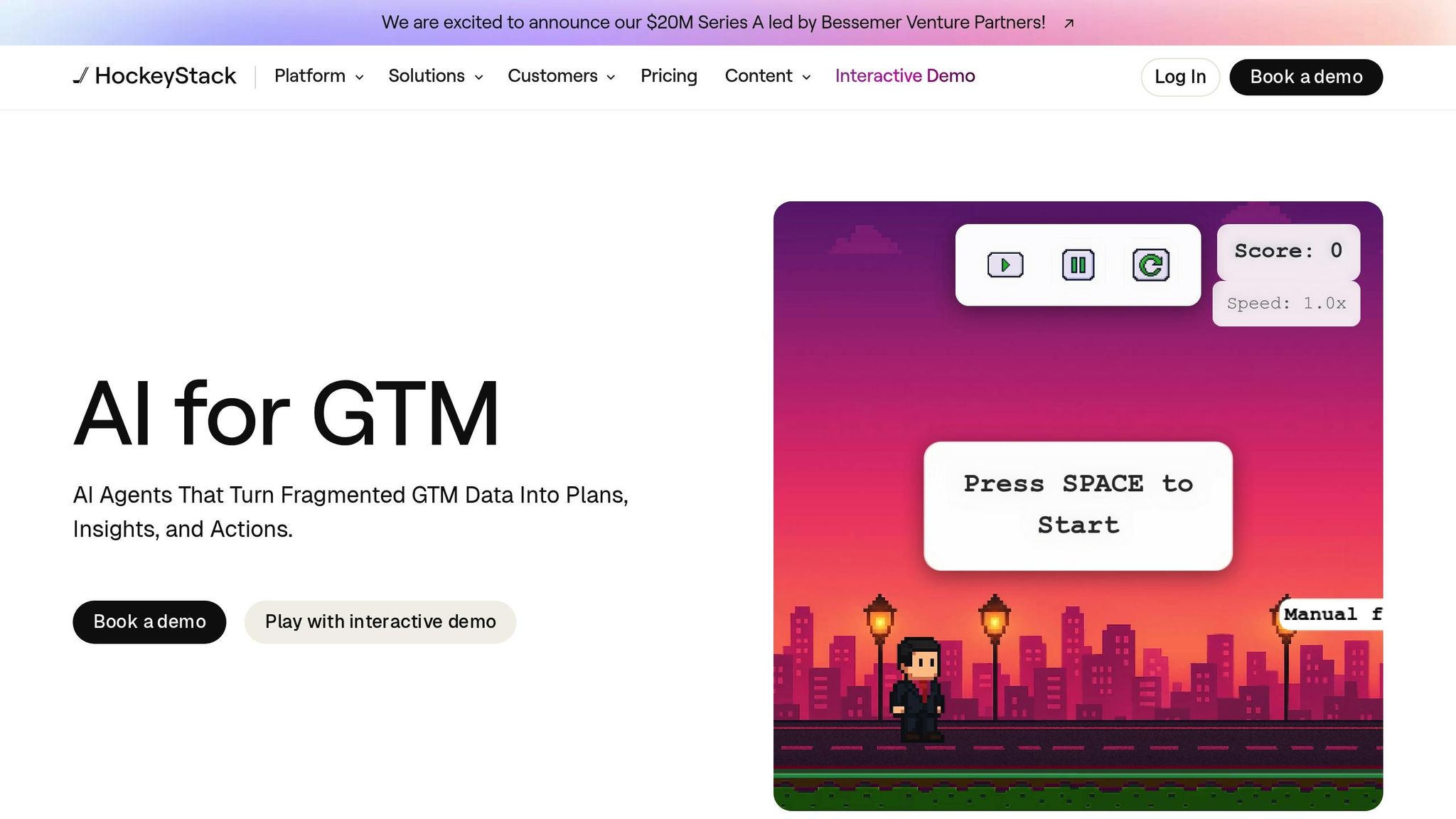
HockeyStack is a revenue acceleration platform designed specifically for B2B companies that need clear, detailed attribution insights. It automatically gathers data from all marketing channels, offering a complete view of the customer journey. With over $20 billion in campaign spend managed by its users, HockeyStack has proven itself capable of addressing even the most complex enterprise-level attribution challenges. Its precision in analytics makes it a strong contender for managing enterprise PPC campaigns.
Support for Custom Attribution Models
HockeyStack stands out with its ability to support custom attribution models. Whether your business needs first-touch, multi-touch, or hybrid models, the platform allows you to tailor attribution to match your specific goals and customer journeys. It offers detailed campaign insights, helping businesses identify the key factors driving conversions and uncover opportunities for improvement. Unlike many other tools, HockeyStack evaluates touchpoints based on their actual influence and incorporates cost data for a more accurate picture. Its user-friendly dashboards and automated data collection streamline the process, enabling teams to focus on strategy and revenue growth.
Integration Capabilities with Data Sources and Marketing Tools
This flexibility in attribution modeling is matched by HockeyStack’s robust integration capabilities. It connects seamlessly with a wide range of tools, processing both structured and unstructured data for comprehensive insights. The platform integrates with major advertising platforms like Google Ads, Facebook Ads, LinkedIn, TikTok, Reddit, Bing Ads, and Adroll. It also works with leading CRM systems such as Salesforce, HubSpot, ActiveCampaign, and Freshsales, as well as marketing automation tools like Salesforce Pardot, Marketo, HubSpot Marketing Hub, and Eloqua.
For instance, Whatfix used HockeyStack to integrate its website with Salesforce, Pardot, and Drift. This integration led to a 100% increase in content-driven opportunities and a 32% rise in closed deals. Additional integrations include ABM platforms like 6sense, Bombora, and Demandbase, data warehouses such as BigQuery and Snowflake, and customer support tools like Drift and Intercom.
Pricing and Cost Structure
HockeyStack’s Marketing Analytics & Attribution plan starts at $2,200 per month for up to 30,000 unique monthly visitors. For businesses with unique needs or larger data volumes, custom plans are available. To get detailed pricing information and ensure the platform aligns with specific requirements, businesses are encouraged to contact HockeyStack directly. This approach ensures that companies can maximize their PPC ROI through tailored attribution insights.
Scalability and Suitability for Different Business Sizes
Thanks to its cloud-based infrastructure, HockeyStack offers real-time data processing and scalability, making it a fit for businesses of all sizes - from startups to large enterprises. Its flexibility allows it to grow alongside organizations, supporting small teams and scaling up to meet enterprise needs. Success stories include ActiveCampaign, which met its monthly revenue goals while cutting ad spend in half, and teams at 8x8 and Delve, who achieved significant growth using the platform.
"HockeyStack has become our marketing source of truth. It centralizes all of our data in one place and allows us to focus our time on understanding and scaling our demand generation efforts."
– Sacha-Leo Shenkier, Senior Manager of Demand Generation at Broadsign
HockeyStack’s recent $20 million Series A funding round highlights investor confidence in its scalability and market impact. Companies like Planful have switched from other attribution tools to HockeyStack, while Airbyte has restructured its entire go-to-market strategy using its AI-driven analytics capabilities. For PPC marketers managing complex attribution across multiple channels, HockeyStack provides the enterprise-grade tools needed for precise modeling while remaining adaptable to changing business demands.
Tool Comparison Table
Here's a quick look at some of the top analytics tools to help you decide which one fits best with your custom attribution models. The table below highlights their key features and strengths.
| Tool | Attribution Models | Key Integrations | Pricing | Best For | Ideal Business Size |
|---|---|---|---|---|---|
| Google Analytics 4 (GA4) | Basic multi-touch models | Google Ads, Google Marketing Platform, Firebase, BigQuery | Free (with paid enterprise features) | Businesses new to attribution tracking | Small to medium businesses |
| Adobe Analytics | AI-powered, sophisticated attribution models | Adobe Experience Cloud, Salesforce, major ad platforms | Tiered pricing (Select, Prime, Ultimate) | Large brands with complex multi-channel campaigns | Enterprise |
| Segment (by Twilio) | Unified data for custom attribution models | Supports data from all marketing channels | Contact for pricing | Businesses needing centralized data collection | Medium to large businesses |
| LeadsRx | Real-time multi-touch attribution, impartial analysis | Major ad platforms, CRM systems, marketing automation tools | Contact for pricing | Complex campaign attribution | Enterprise |
| HockeyStack | Flexible models for B2B attribution | Salesforce, HubSpot, Google Ads | Contact for pricing | Tailored attribution for B2B companies | Medium to enterprise |
Highlights of Each Tool
- Google Analytics 4 (GA4): A great starting point for businesses, offering basic multi-touch attribution models with a free plan and seamless integration with Google products.
- Adobe Analytics: Ideal for enterprises, this tool uses AI to create advanced attribution models and offers flexible pricing tiers depending on your needs.
- Segment (by Twilio): Perfect for businesses that need to unify marketing data from multiple channels to build custom attribution models.
- LeadsRx: Known for its real-time data processing and unbiased analysis, it’s a strong choice for optimizing complex campaigns.
- HockeyStack: Designed for B2B companies, it provides flexible attribution models and integrates with popular tools like Salesforce and HubSpot.
Choosing the right tool comes down to your business size, the complexity of your campaigns, and your integration and budget requirements.
Conclusion
Choosing the right analytics tool for your custom attribution models depends on a clear understanding of your business needs, the complexity of your campaigns, and the integration requirements. The tools we've discussed offer diverse features - from the user-friendly approach of Google Analytics 4 for smaller businesses to the advanced capabilities of Adobe Analytics - ensuring there's an option to suit your campaign goals and growth ambitions. The next step is to align your choice with your specific objectives and integration needs.
Before diving in, take time to define your campaign goals. Whether you're aiming to boost brand awareness or drive direct conversions, your attribution model should directly support these targets.
Effective attribution can make a big difference in PPC performance. On average, businesses see $2 in revenue for every $1 spent on PPC. These tools can pinpoint which touchpoints are driving conversions, helping you allocate budgets to high-performing channels and cut back on those that underperform.
It’s also worth experimenting with different attribution models to find the best fit for your goals. Don’t forget to link your CRM data to capture offline conversions and use cross-device tracking to follow customers as they switch between mobile and desktop.
Optimization is an ongoing process. Regularly review your strategy using the insights from your analytics tools to ensure it stays relevant in an ever-changing marketing landscape. Interactive dashboards can provide a clear view of customer journeys, while data segmentation helps you identify trends and make informed decisions about where to allocate your PPC budget. By integrating your PPC analysis with broader business goals, you can drive revenue and hit your key performance targets. For context, the average conversion rate on Google Ads across all industries was 7.17% in 2025. The right attribution tool can highlight areas for improvement and help you stay competitive.
Select a tool that meets your current needs but also has the flexibility to grow with your business. Whether you’re starting with simple multi-touch models or need advanced AI-driven attribution, building a strong analytics foundation is critical for improving how you measure and optimize your PPC campaigns.
FAQs
How can I choose the best attribution tool for my business and marketing goals?
Selecting the right attribution tool comes down to a few key factors: the size of your business, your marketing objectives, and how complex your campaigns are.
For small to medium-sized businesses, simpler tools with multi-touch attribution models are often a great fit. These tools are typically easier to set up and provide clear insights without overwhelming you with data. On the flip side, larger enterprises usually need more sophisticated solutions. Advanced cross-channel platforms can handle large volumes of data and manage campaigns that span multiple platforms.
When evaluating options, think about what you want to achieve. Are you aiming to maximize ROI, get a clearer picture of the customer journey, or seamlessly connect with tools like your CRM or ad platforms? Choosing a tool that aligns with these goals ensures it becomes a valuable part of your marketing strategy.
What’s the difference between multi-touch and custom attribution models?
Multi-touch attribution models assign credit to multiple touchpoints along the customer journey, recognizing the role each interaction plays in driving a conversion. This method reflects the complexity of today’s buying behaviors, ensuring that credit is distributed across all significant engagements.
Custom attribution models, however, are tailored to match a business's specific objectives. They let you allocate credit based on custom rules or algorithms, often giving more weight to certain touchpoints or sequences that align closely with your strategy.
To put it simply: multi-touch models highlight a broader view of the journey, while custom models focus on aligning attribution with your unique business goals.
How does integrating CRM data improve the performance of my attribution model?
Integrating CRM data into your attribution model gives you a more detailed view of your customers' journeys. It highlights which marketing efforts are genuinely driving conversions, allowing you to craft tailored campaigns and spend your budget where it counts most.
When you blend CRM insights with attribution data, you gain a sharper understanding of ROI. This approach helps pinpoint high-performing channels, fine-tune how resources are allocated, and improve the overall impact of your marketing strategy.
